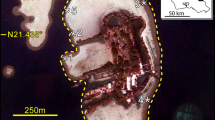Abstract
This note reports an unknown trophic interaction between a mammalian herbivore, the capybara (Hydrochaeris hydrochaeris), and the seagrassRuppia maritima (wigeongrass) and compares the feeding behavior of capybaras to other seagrass grazers. Observations were made in Spring 2002 in the Barra Grande, a small, shallow, moderately stratified, bar-built estuary at Ilha Grande, Rio de Janeiro State, southeast Brazil. The activities of the capybaras were investigated and grazing impacts were quantified in situ. The capybaras were observed feeding onR. maritima during the day and aquatic feeding alternated with periods of feeding on land.R. maritima was the only submerged aquatic vegetation to be consumed by the capybaras. The feeding activity of the capybaras on wige ongrass consisted of alternately diving down to theR. maritima then surfacing; the capybaras spent a significantly greater amount of time under water. In the area where the capybaras foraged 18.1% of the seagrass meadow showed recent grazing scars. Vegetation of recently and not recently grazed areas were compared. Grazing scars, which were slightly elongated, were not completely devoid ofR. maritima but presented reduced standing crop: canopy height, shoot density, and shoot, rhizome, and root biomass were reduced in grazed areas. The grazing patterns observed in capybaras resembled those previously reported in the sirenia, mammals that include two seagrass-eating species.
Similar content being viewed by others
Literature Cited
Adair, S. E., J. L. Moorf, andC. P. Onuf. 1994. Distribution and status of submerged vegetation in estuaries of the upper Texas coast.Wetlands 14:110–121.
Borowitzka, M. A. andR. L. Lethbridge. 1989. Seagrass epiphytes, p. 458–499.In A. W. D. Larkum, A. J. McComb, and S. A. Shepherd (eds.), Biology of Seagrasses: A Treatise on the Biology of Seagrasses with Special Reference to the Australian Region. Elsevier, Amsterdam, The Netherlands.
Creed, J. C. 2000. The biodiversity of Brazil’s seagrass and seagrass habitats: A first analysis.Biologia Marina Mediterranea 7: 207–210.
de Iongh, H. H., B. J. Wenno, andE. Meelis. 1995. Seagrass distribution and seasonal biomass changes in relation to dugong grazing in the Moluccas, East Indonesia.Aquatic Botany 50:1–19.
den Hartog, C. 1972. The sea-grasses of Brazil.Acta Botanica Neerlandica 21:512–516.
Duarte, C. M. 2000. Marine biodiversity and ecosystem services: An elusive link.Journal of Experimental Marine Biology and Ecology 250:117–131.
Emmons, L. H. 1990. Neotropical Rainforest Mammals: A Field Guide. The University of Chicago Press. Chicago, Illinois.
Hemminga, M. A. andC. M. Duarte. 2000. Seagrass Ecology. Cambridge University Press, Cambridge, U.K.
Kantrud, H. A. 1991. Wigeongrass (Ruppia maritima L.): A literature review.Fish and Wildlife Research 10:1–58.
Kopschitz, I. 2003. O Pantanal é aqui.O Globo 25448:11.
McRoy, C. P. andC. Helfferich. 1980. Applied aspects of seagrasses, p. 297–343.In R. C. Phillips and C. P. McRoy (eds.), Handbook of Seagrass Biology: An Ecosystem Perspective. Garland STPM Press, New York.
Mendes, A., S. S. C. Nogueira, S. Lavorenti, andS. L. G. Nogueira-Filho. 2000. A note on the cecotrophy behavior in capybaraHydrochaeris hydrochaeris.Applied Animal Behaviour Science 66:161–167.
Oliveira, E. C., J. R. Pirani, andA. M. Giulietti. 1983. The Brazilian seagrasses.Aquatic Botany 16:251–267.
Phillips, R. C. 1992. The seagrass ecosystem and resources in Latin America, p. 107–121.In U. Seeliger (ed.), Coastal Plant Communities of Latin America. Academic Press, San Diego, California.
Preen, A. 1995. Impacts of dugong foraging on seagrass habitats: Observational and experimental evidence for cultivation grazing.Marine Ecology Progress Series 124:201–213.
Provancha, J. A. andC. R. Hall. 1991. Observations of association between seagrass beds and manatees in East Central Florida.Florida Scientist 54:87–98.
Short, F. T. andR. G. Coles (eds.). 2001. Global Seagrass Methods. Elsevier Science B.V., Amsterdam, The Netherlands.
Short, F. T., R. G. Coles, andC. Pergent-Martini. 2001. Global seagrass distribution, p. 5–30.In F. T. Short and R. G. Coles (eds.), Global Seagrass Methods. Elsevier Science B.V., Amsterdam, The Netherlands.
Thayer, G. W., K. A. Bjorndal, J. C. Ogden, S. L. Williams, andJ. C. Zieman. 1984. Role of larger herbivores in seagrass communities.Estuaries 7:351–376.
Valentine, J. F. andK. L. Heck. 1999. Seagrass herbivory: Evidence for the continued grazing of marine grasses.Marine Ecology Progress Series 176:291–302.
Zar, J. H. 1984. Biostatistical Analysis, 2nd edition, Prentice-Hall International, London, U.K.
Zieman, J. C. 1982. The ecology of seagrasses of South Florida: A community profile. FWS/OBS 82/25. U.S. Fish and Wildlife Service, Office of Biological Services. Washington, D.C.
Sources of Unpublished Materials
Barreto, M. R. Personal Communication. Universidade do Estado do Rio de Janeiro, Rua São Frnacisco Xavier 524, 20559900, Rio de Janeiro, RJ, Brazil.
Campos, D. B. Unpublished Data. Universidade do Estado do Rio de Janeiro, Rua São Francisco Xavier 524, 20559-900, Rio de Janeiro, RJ, Brazil.
Author information
Authors and Affiliations
Rights and permissions
About this article
Cite this article
Creed, J.C. Capybara (Hydrochaeris hydrochaeris rodentia: Hydrochaeridae): A mammalian seagrass herbivore. Estuaries 27, 197–200 (2004). https://doi.org/10.1007/BF02803376
Received:
Revised:
Accepted:
Issue Date:
DOI: https://doi.org/10.1007/BF02803376




